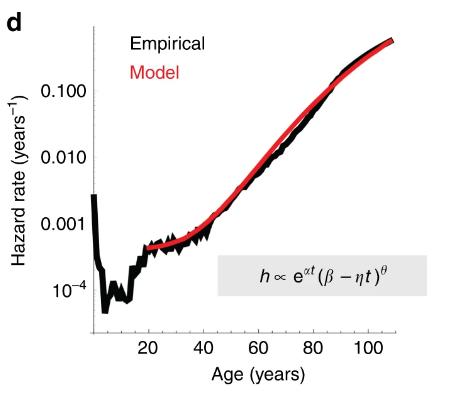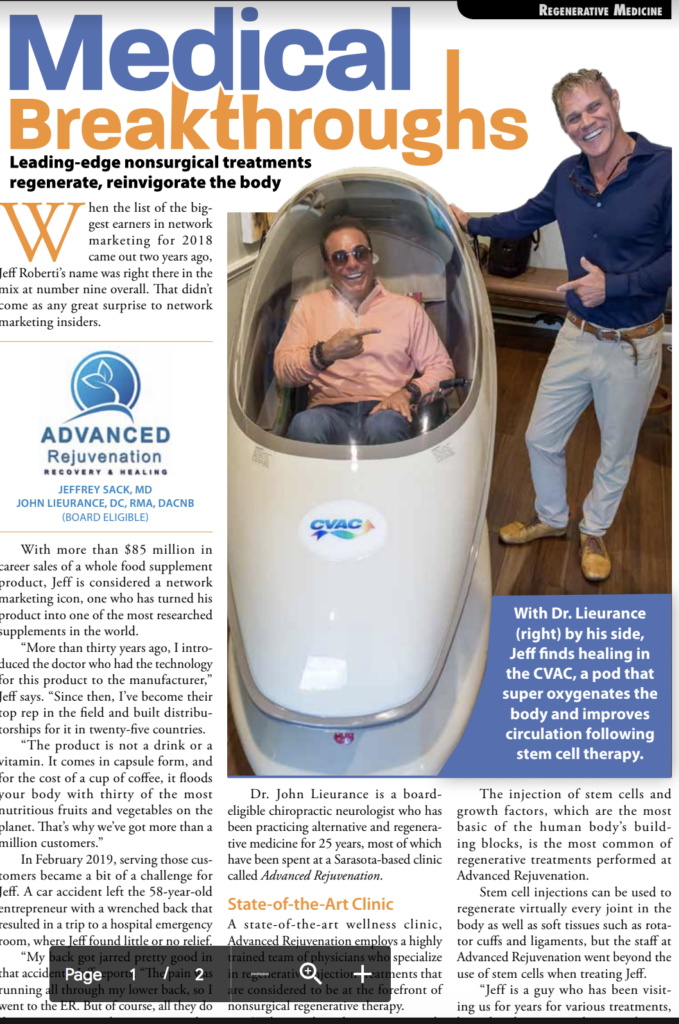Senescent increase with age which cause degenerative effects & cancer in humans! Dr John’s Protocol.
A model of senescent cell turnover and accumulation (red) almost exactly matches real human mortality statistics.

Senescent cells (SnCs) accumulate with age! Senescent cells are cells that go into a permanent state of sleep like a zombie and continue to consume energy and product lots of oxidation! Senescent cells secrete pro-inflammatory chemicals form something scientist call SASP (senescence-associated secretory phenotype). The SASP’s is thought to significantly contribute to aging [12] and cancer [13]! Senolytics which remove SASP’s are a great strategy for promoting health and longevity.
Poor energy levels at a cellular level are a headwind for the body to properly clear out these zombie cells. Mitochondria, the power house of the cell, it a key component to this cellular energy. Both NAD+ as well as mitochondria health decline with age. Fisetin, Resveritol, NAD+ (ALL in NeuroNAD™ Bullet and also see Lucitol™) all work to mop up these senescent cells (synolytic). Fisetin in particular is one of the more powerful synolytic known to man! See my article on Fisetin here. Fasting is also a great way to clean up cellular senescence! I often have my patents a 90 day protocol using Fasting, NAD+ & Polyphenols.
ABC NAD+ Fasting Senolytic Protocol:
- Fast every day within a 8-10 hour window- This is called time restricted eating!
- Fast 24 hours 1 day every week usually lunch to lunch.
- Do a 3-5 day prolonged fast every 6 months or each month for 3 months consecutively if there is a serious health condition we are addressing!
- During fasting window 3-5 days a week I have them take either NeuroNAD™ Bullet or Lucitol™ Bullet, in the morning usually. As an added stack to further drive up NAD+ levels I will have them also use the NeuroNAD™ 2-3 times a day.
- ResveraCel– 1 capsule 2 times a day. ResveraCel is a precursor to NAD+ called Nicotinamide riboside (NR).
- Deep sleep is a big activator of the Glymphatic system which is the detox pumping system in the brain. Using Super high physiologic melatonin dosing with Sandman™ Bullet is a great product to really kick in the glymphatic system thus brain detoxification. This ensures that these senescent cells will be cleared our of the nervous system! Sandman can be taken nightly or 3-5 days a week. See Dr John’s Deep Dive into Deep Sleep Lecture here.
The ABC NAD+ Fasting Senolytic Protocol can be done without fasting is the ABC NAD+ Refuel Protocol. See an example of this protocol here.
ABC NAD+ Fasting Senolytic Protocol is a great home program anyone can use however for those who really would like to step the game up we also use 10 pass Hyperbaric ozone IV’s. Ozone is particularly good at cleaning up weak and dysfunctional cells and mitochondria! At home you might consider buying an ozone generator and doing ozone rectally! It wont be as powerful as IV and 10 pass is the strongest form of 10 ozone however it is expensive and we charge 1,000/ IV. See 10 pass clinic here. One can find an ozone generator with all the attachments for 2,000 or so. Best investment you can make in my opinion! You an contact me at [email protected] if you would like some help in finding the right ozone machine for you.
Another amazing device for those who would like to step up the game is CVAC. Cyclic Variations in Adaptive Conditioning™ is a way to condition the body, improve oxygenation and it is a powerful glymphatic pump! Using the CVAC daily for a few weeks can really jump start healing and deep cleansing of the nervous system and body. The CVAC™ can do much for the heart and cardiovascular system as well.

Find out about our 2-3 week senescent cell protocol using CVAC™, 10 Pass, Fasting and our ABC products! Email [email protected].
NAD+ IV Therapy can also be a more powerful way to quickly ramp up NAD+ levels in the body. Here is a link to more information and how to receive NAD+ IV.
Lets take a look into some studies and research on NAD+.
In a study, removing only thirty percent of senescent cells was sufficient to slow down age-related decline. These results suggest the feasibility of selectively ablating senescent cells and the efficacy of senolytics in alleviating the diseases of aging and promoting healthy longevity [1, 2, 3].
Further confirming the potential of senolytics to treat age-related disease, a recent study demonstrated the benefits of senolytics for certain aspects of vascular aging [3]. This was the first study to show that clearance of senescent cells improves aspects of vascular aging and chronic hypercholesterolemia, thus making senolytics a possible viable method of reducing morbidity and mortality from cardiovascular diseases.
Even more recently, progress has been made in treating atherosclerosis using senolytics to address the “foam cells” that contribute to this disease [4]. There has also been progress in ways to treat type 2 diabetes using senescent cell removal [6]. Senolytics also have the potential for slowing skin aging [9] and treating osteoarthritis [8].
In other studies, removing only thirty percent of senescent cells was sufficient to slow down age-related decline. These results suggest the feasibility of selectively ablating senescent cells and the efficacy of senolytics in alleviating the diseases of aging and promoting healthy longevity [1, 2, 3].
Further confirming the potential of senolytics to treat age-related disease, a recent study demonstrated the benefits of senolytics for certain aspects of vascular aging [4]. This was the first study to show that clearance of senescent cells improves aspects of vascular aging and chronic hypercholesterolemia, thus making senolytics a possible viable method of reducing morbidity and mortality from cardiovascular diseases.
Even more recently, progress has been made in treating atherosclerosis using senolytics to address the “foam cells” that contribute to this disease [5]. There has also been progress in ways to treat type 2 diabetes using senescent cell removal [6]. Senolytics also have the potential for slowing skin aging [7] and treating osteoarthritis [8].
In other studies, removing only thirty percent of senescent cells was sufficient to slow down age-related decline. These results suggest the feasibility of selectively ablating senescent cells and the efficacy of senolytics in alleviating the diseases of aging and promoting healthy longevity [1, 2, 3].
Further confirming the potential of senolytics to treat age-related disease, a recent study demonstrated the benefits of senolytics for certain aspects of vascular aging [4]. This was the first study to show that clearance of senescent cells improves aspects of vascular aging and chronic hypercholesterolemia, thus making senolytics a possible viable method of reducing morbidity and mortality from cardiovascular diseases.
Even more recently, progress has been made in treating atherosclerosis using senolytics to address the “foam cells” that contribute to this disease [5]. There has also been progress in ways to treat type 2 diabetes using senescent cell removal [6]. Senolytics also have the potential for slowing skin aging [7] and treating osteoarthritis [8].
In other studies, removing only thirty percent of senescent cells was sufficient to slow down age-related decline. These results suggest the feasibility of selectively ablating senescent cells and the efficacy of senolytics in alleviating the diseases of aging and promoting healthy longevity [1, 2, 3].
Further confirming the potential of senolytics to treat age-related disease, a recent study demonstrated the benefits of senolytics for certain aspects of vascular aging [4]. This was the first study to show that clearance of senescent cells improves aspects of vascular aging and chronic hypercholesterolemia, thus making senolytics a possible viable method of reducing morbidity and mortality from cardiovascular diseases.
Even more recently, progress has been made in treating atherosclerosis using senolytics to address the “foam cells” that contribute to this disease.[4]. There has also been progress in ways to treat type 2 diabetes using senescent cell removal [8]. Senolytics also have the potential for slowing skin aging [6] and treating osteoarthritis [7].
David Sinclair is considered a leading authority on extending lifespan and NAD+. Here is a great video lecture he did with my comments.
[1] Tchkonia, T., Zhu, Y., Van Deursen, J., Campisi, J., & Kirkland, J. L. (2013). Cellular senescence and the senescent secretory phenotype: therapeutic opportunities. The Journal of clinical investigation, 123(3), 966-972.
[2] Zhu, Y., Armstrong, J. L., Tchkonia, T., & Kirkland, J. L. (2014). Cellular senescence and the senescent secretory phenotype in age-related chronic diseases. Current Opinion in Clinical Nutrition & Metabolic Care, 17(4), 324-328.
[3] Zhu, Y., Tchkonia, T., Pirtskhalava, T., Gower, A. C., Ding, H., Giorgadze, N., … & O’Hara, S. P. (2015). The Achilles’ heel of senescent cells: from transcriptome to senolytic drugs. Aging cell, 14(4), 644-658.
[4] Roos, C. M., Zhang, B., Palmer, A. K., Ogrodnik, M. B., Pirtskhalava, T., Thalji, N. M., … & Zhu, Y. (2016). Chronic senolytic treatment alleviates established vasomotor dysfunction in aged or atherosclerotic mice. Aging cell.
[5] Childs, B. G., Baker, D. J., Wijshake, T., Conover, C. A., Campisi, J., & van Deursen, J. M. (2016). Senescent intimal foam cells are deleterious at all stages of atherosclerosis. Science, 354(6311), 472-477.
[6] Palmer, A. K., Tchkonia, T., LeBrasseur, N. K., Chini, E. N., Xu, M., & Kirkland, J. L. (2015). Cellular senescence in type 2 diabetes: a therapeutic opportunity. Diabetes, 64(7), 2289-2298.
[7] Velarde, M. C., & Demaria, M. (2016). Targeting Senescent Cells: Possible Implications for Delaying Skin Aging: A Mini-Review. Gerontology.
[8] Xu, M., Bradley, E. W., Weivoda, M. M., Hwang, S. M., Pirtskhalava, T., Decklever, T., … & Lowe, V. (2016). Transplanted Senescent Cells Induce an Osteoarthritis-Like Condition in Mice. The Journals of Gerontology Series A: Biological Sciences and Medical Sciences, glw154.
[9] Lluc Mosteiro, Cristina Pantoja, Noelia Alcazar et al. (2016) Tissue damage and senescence provide critical signals for cellular reprogramming in vivo. Science, 354(6315).
[10] Demaria, M., Ohtani, N., Youssef, S. A., Rodier, F., Toussaint, W., Mitchell, J. R., … & Hoeijmakers, J. H. (2014). An essential role for senescent cells in optimal wound healing through secretion of PDGF-AA. Developmental cell, 31(6), 722-733.
[11] Tominaga, K. (2015). The emerging role of senescent cells in tissue homeostasis and pathophysiology. Pathobiology of Aging & Age-Related Diseases, 5.
[12] Freund, A., Orjalo, A. V., Desprez, P. Y., & Campisi, J. (2010). Inflammatory networks during cellular senescence: causes and consequences. Trends in molecular medicine, 16(5), 238-246.
[13] Coppé, J. P., Desprez, P. Y., Krtolica, A., & Campisi, J. (2010). The senescence-associated secretory phenotype: the dark side of tumor suppression. Annual review of pathology, 5, 99.
